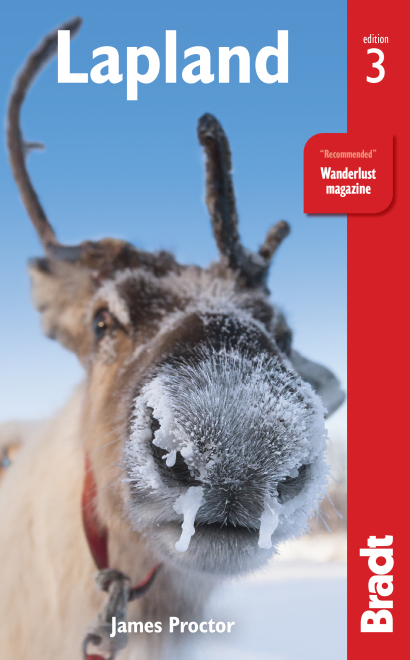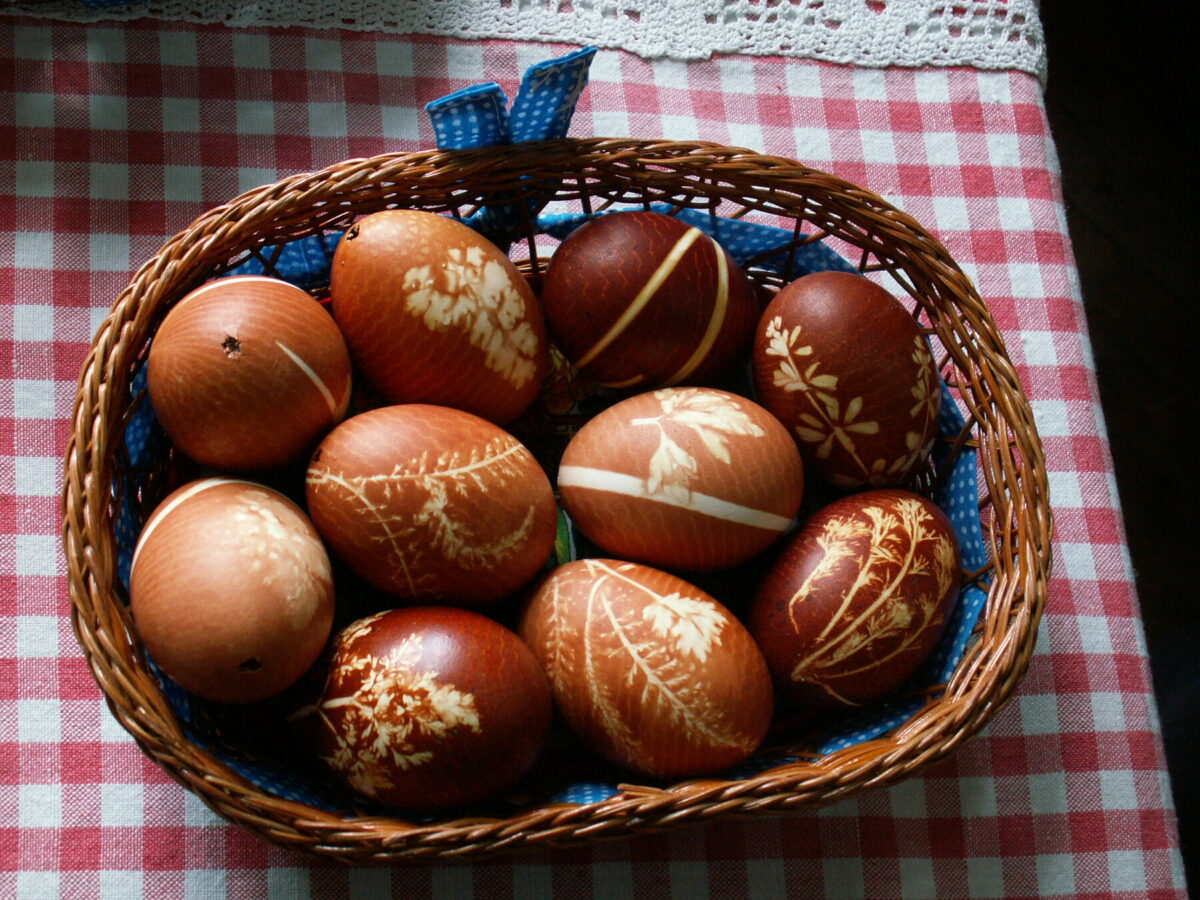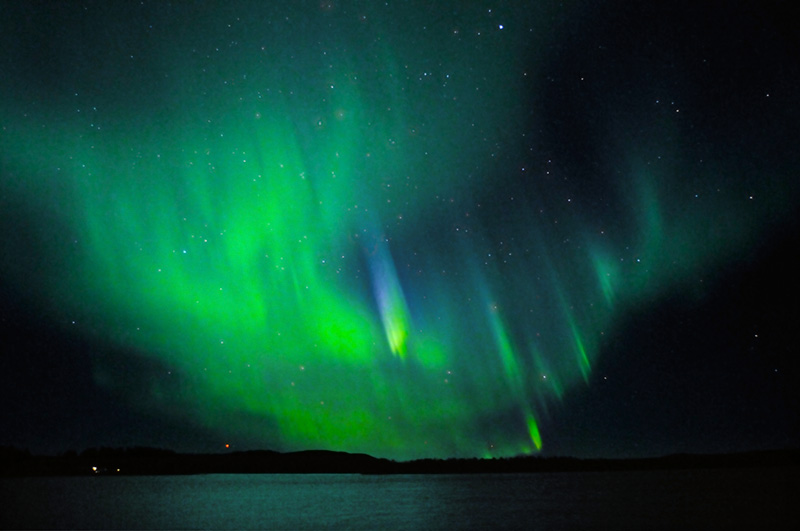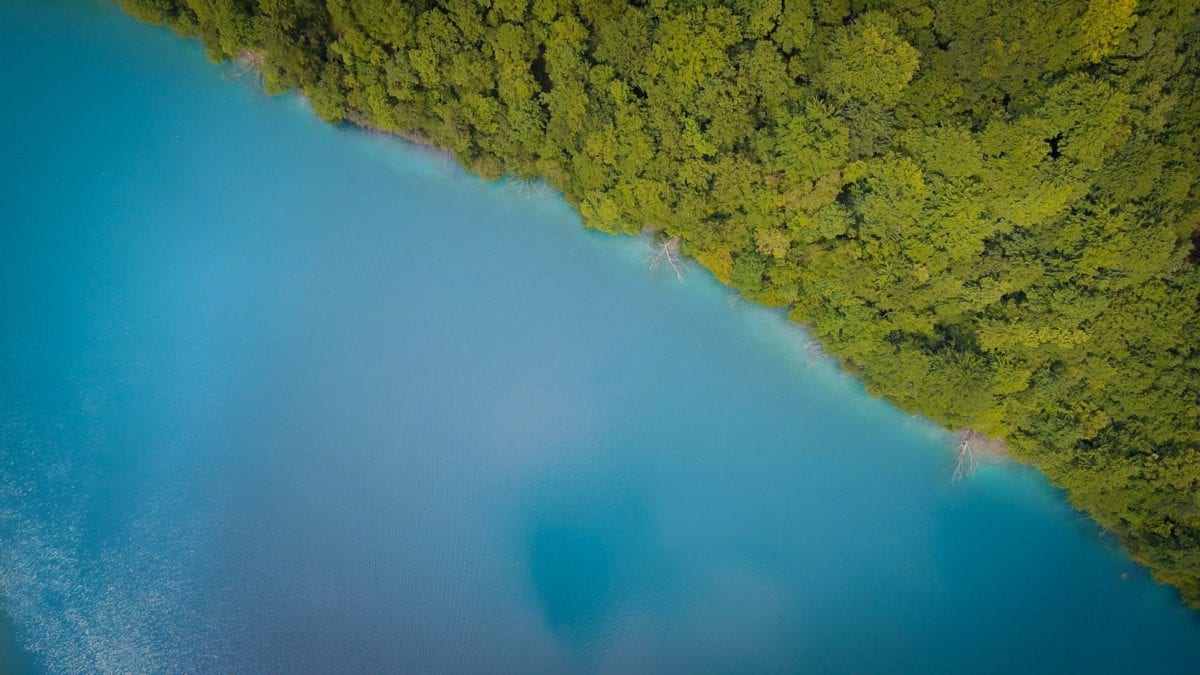Visit Norwegian, Swedish or Finnish Lapland and you’ll take away much more than Santa Claus could ever give you.
James Proctor, author of Lapland: the Bradt Guide
For a place that doesn’t officially exist, Lapland is famous the world over. Children know this snowy winter wonderland as the home of Santa Claus and his illustrious red-nosed reindeer, Rudolph, who take to the starry skies over Lapland every Christmas Eve to deliver presents and goodies to homes across the globe, a truly remarkable feat of aviation, timetabling and largesse that leaves even the world’s favourite airlines lost for words. However, beyond the popular image of Lapland, little is known about this mysterious region lost somewhere on the very fringes of Europe.
First-time visitors are often astonished at the sheer variety of Lapland’s landscapes: classic Norwegian fjords amid some of the most awe-inspiring mountain scenery anywhere in Europe; sweeping forests of pine and spruce that cloak the great inland plateaux of Swedish Lapland; and austere, treeless fells surrounded by steely grey lakes and unforgiving marshes that give Finnish Lapland its very individual character. This is Scandinavia at its most elemental. Thanks to good road, rail and air links, travel between the different regions of Lapland is straightforward, making it perfectly possible to visit Santa Claus in Finland, spend a night at the Icehotel in Sweden and go island-hopping in Norway all on the same trip. True, winter temperatures can plummet to –30°C and below, but public transport in Lapland is reliable, accommodation is warm and snug and eating out offers up a variety of options; reindeer, a local source of low-fat nutrition that’s been consumed by generations of Laplanders, could even be on the menu.
Inevitably, the indigenous inhabitants of Lapland, the Sámi (who dislike the name ‘Lapps’, which was imposed on them by insensitive southerners) are today a minority in their own land and make up barely 7% of the total population. The promotion of Sámi culture is widespread and efforts to save the seven (or arguably nine) different dialects of the Sámi tongue from extinction have met with some success. Travel across Lapland and sooner or later you’ll see Sámi in their brightly coloured traditional dress – this is sometimes put on for tourists, but at key festivals in the Sámi calendar wearing these clothes is a sign of pride and fraternity. The nomadic lifestyle may have all but disappeared but there’s still a strong sense of community, which reaches across national borders.
Inextricably drawn to last places, I first travelled to Lapland in 1983 and have been a regular visitor ever since. There’s quite simply something about the sheer austerity of the nature – and, at times, the gruffness of the people who choose to live high inside the Arctic Circle – that fascinates me. Lapland may be at its most magical during the long winter months when daylight is in short supply and snow lies thick on the ground – it’s certainly the perfect time to head out on a snowmobile tour or a dog-sled safari, or, indeed, to curl up with a good book beside a wood-burning stove inside a log cabin – but it’s equally alluring in summer when the midnight sun and the quality of the light in the northern sky are perhaps two of the most difficult things about Lapland to qualify on paper. Visit Norwegian, Swedish or Finnish Lapland and you’ll take away much more than Santa Claus could ever give you.
Food and drink in Lapland
Food
In the bigger towns and cities across Lapland you will find a wide range of eateries. In addition to the regular Nordic restaurants serving traditional specialities such as Arctic char and reindeer in its various guises, over recent years there has been a profusion of Thai restaurants, which can make a tasty change to the ubiquitous pizzerias that line the streets of northern Scandinavia. Chinese restaurants and burger bars are common. In smaller towns, hotel restaurants are generally the best place to find quality food. Cafés can be a good place to pick up an open sandwich piled high with various toppings such as prawns or meatballs, though they are generally closed on Sundays. It is generally not necessary to book a table in a restaurant in Lapland.
Breakfast is a perfect way to fuel up for the day. Hotels and guesthouses in all three countries provide a generous help-yourself buffet (included in the room rate) with yoghurt, cereals, ham, cheese, bacon, egg, herring, coffee and juice. You simply take what you want and return to the table as many times as you like.
Lunch varies from country to country. In Norway (lunsj in Norwegian) it consists mostly of a sandwich bought from a café, whereas in Sweden and Finland you should look out for the set lunch special (dagens rätt/dagens lunch in Swedish; lounas in Finnish), which offers an extremely economical way of enjoying a good meal. Served from 11.00 to 14.00 between Monday and Friday, it generally consists of a choice of two or three main dishes, plus salad, bread, a soft drink or a low-alcohol beer and coffee – all for around 85–95SEK/€8–9. By switching your main meal of the day to lunchtime, you’ll save a packet.
Eating dinner à la carte in the evening is a more expensive undertaking, although much more so in Norway than in Sweden and Finland. Many mid-range restaurants in Lapland serve local specialities, in particular reindeer. While non-Scandinavians are sometimes wary about eating reindeer, it is without doubt the dish of choice for most people of the far north. In taste it resembles beef, though with a more gamey flavour. It’s extremely low in fat and comes in several varieties:
- Thin slices of sautéed reindeer meat (a bit like kebab meat to look at), usually served in a deliciously creamy mushroom sauce with mashed potatoes and lingonberries, are known as poronkäristys in Finnish, finnbiff in Norwegian and renskav in Swedish
- Suovas (Sámi for ‘smoked’) is salted reindeer meat, which is cold-smoked and served in small rounds
- The other main alternative is a regular steak of reindeer meat, mouth- wateringly tender and very lean, known as poronpaisti in Finnish, reinsdyrstek in Norwegian and renstek/renytterfilé in Swedish
Remember that by ordering reindeer from the menu you’re choosing to support a strategic part of the Lapland economy.
Drink
Finland is the cheapest country in which to buy alcohol, closely followed by Sweden, with Norway off the scale. All three Nordic countries operate a restrictive system of alcohol sales aimed at limiting the amount of alcohol people consume. State-run stores known as vinmonopolet (Norway), alko (Finland) and systembolaget (Sweden) are open office hours Monday–Friday and generally on Saturday morning and are found in the larger towns and villages across the region. They are never open in the evening, on Sunday or on public holidays. These shops are the only places to buy wine, strong beer and spirits – the only alcohol available in supermarkets is beer with a maximum alcohol content of 4.5°, in the case of Finland and Norway, or a watery 3.5° in Sweden.
Naturally, alcohol is available in restaurants and bars at higher prices than in the stores. In Norway you should expect to pay 85–100NOK for half a litre of beer in a bar; in Sweden around 75–85SEK; and in Finland about €4.50–6.50.
Health and safety in Lapland
Health
Health risks
The health risks while travelling in Lapland are minimal and healthcare is of an excellent standard. Visitors should be up to date with childhood vaccinations, including MMR. Rabies is only present in bats in Lapland – although contact with them is highly unlikely – but a bite from any mammal should be followed by a trip to the doctor.
Language (except occasionally in Finland) is rarely a problem and health workers are generally proficient in English. Under reciprocal health arrangements, European Union citizens (plus those of EEA countries) can take advantage of Finland and Sweden’s healthcare services under the same terms as residents of those countries. All that’s required is a European Health Insurance Card (EHIC), which is available via the post office in the United Kingdom and Ireland; the EHIC has replaced the old E111 form. Note that when the UK officially leaves the European Union, British visitors may need to take out separate medical travel insurance in order to be covered while travelling in Finland and Sweden. Check before travelling.
Citizens of non-EU/EEA countries are liable to pay for healthcare, hence, it is probably sensible to make sure you have health insurance before leaving home. Rules for Norway are slightly different since the country is not a member of the European Union: EU/EEA citizens are entitled to discounted medical treatment within the national public healthcare system; citizens of other countries receive no discount. All citizens may therefore want to consider taking out health insurance to cover any health bills while in Norway.
Tick-borne encephalitis
Caused by a virus in the same family as yellow fever, tick-borne encephalitis is spread through the bites of infected ticks which are usually picked up in forested areas with long grass, and it can also be transmitted through the unpasteurised milk of infected livestock. Anyone liable to go walking in late spring or summer (when the ticks are most active) should seek protection. A vaccine is available against the disease and initial immunisation ideally consists of three injections. The second is given one to three months after the first and the third five to 12 months later. If time does not allow for the third dose, around 90% protection is given by the first two and, if time is shorter still, then the second dose can be done two weeks after the first. There is a different vaccine for children aged one to 15 (Ticovac Junior) but the schedule is the same.
Taking preventative measures is also very important. When walking in grassy and forested areas, ensure that you wear a hat, tuck your trousers into socks and boots and your shirt into your trousers, have long-sleeved tops and use tick repellents. Ticks can more easily be seen on pale clothing and can be flicked off before they get a grip on you, so consider your clothing carefully. It is important to check for ticks each time you have been for a long walk – this is more easily done by someone else. If you find a tick then slowly remove it, taking care not to squeeze the mouthparts.
Safety
Two particular hazards to bear in mind when travelling in Lapland are the heightened risk of road accidents as a result of the large number of wild animals on the road, especially reindeer, and the effects of cold during the winter months.
Female travellers
Women travelling alone are unlikely to encounter any problems. Nordic males are generally well mannered and far too shy to create trouble. On Friday and Saturday nights, though, when the beer starts to flow, it’s obviously sensible to keep your wits about you, but, once again, you are unlikely to become the target of abusive behaviour.
LGBTQ+ travellers
Gay travellers will have to forego the pleasures of gay bars and clubs while in Lapland – quite simply, there is no gay scene whatsoever. Attitudes towards homosexuality are generally tolerant, though the views of unmarried lumberjack types may not be the most enlightened. The sight of a same-sex couple walking hand in hand through a remote Lapland village, particularly with a large Sámi community, is likely to cause quite a stir, so it’s probably best to keep outward displays of affection to yourselves.
Travelling with a disability
Finland, Norway and Sweden, as you might expect, are model countries when it comes to meeting the needs of disabled travellers. Throughout Lapland you’ll find hotels with rooms specifically designed for disabled access and trains with special hydraulic lifts which are designed to get wheelchairs in and out of carriages with a minimum of fuss. Buses, too, are often fitted with a divide which allows the front of the vehicle to drop down closer to the ground to ease disabled access.
The Hurtigruten ferry in Norway is also geared up to disabled travel with special lifts and cabins for disabled users. Winter, though, can be a tough time for wheelchair users as pavements are rarely completely free of snow and ice and can be extremely difficult to negotiate.
Travelling with children
Naturally, Lapland is a magnet for children, enchanted by the wonders of Santa Claus and Rudolph. Travel companies, particularly in and around Rovaniemi in Finland, understand that many travellers come to Lapland purely because of their children. Accordingly, they have made sure that there are plenty of activities on hand to keep younger travellers busy and contented. Public transport, too, is well equipped and provides easy access for pushchairs and prams. Many trains have separate family carriages where there’s a play corner for children, making it possible to supervise children at play from your seat.
However, it’s important not to underestimate the severe climatic conditions which you are more than likely to encounter when you disembark the plane or train on arrival in winter; it is not uncommon for temperatures to stubbornly hover around the –30°C mark which poses a serious challenge to outdoor exploration. Hence, you should make sure you have plenty of warm clothing, hats, gloves and scarves to protect against the extreme cold. Remember, too, that children may find the 24-hour darkness of winter Lapland disorientating, not to say boring. Conversely, in summer, it may be hard to get children to sleep when it never gets dark!
Travel and visas in Lapland
Getting there and away
Given the tremendous distances involved in reaching Lapland, even from elsewhere in Scandinavia, the only feasible way of getting there is by air. Naturally, it is possible to drive to Lapland as part of a greater European tour, but consider just how far it is: London to Kiruna, for example, is 3,000km one-way.
By air
The main airports to aim for in Lapland are Kiruna (KRN), Luleå (LLA), Narvik/Harstad (EVE), Tromsø (TOS), Rovaniemi (RVN) and Ivalo (IVL), but flying to Lapland will generally entail first reaching one of the Nordic capitals and then changing planes for a domestic flight to one of the airports listed above.
The best transit airports to aim for when heading for Lapland are Stockholm Arlanda (ARN), Oslo Gardermoen (OSL) or Helsinki Vantaa (HEL). Copenhagen’s Kastrup airport, although the biggest hub in Scandinavia, has no direct flights to Lapland and is worth avoiding for that reason. The duration of the flight from one of these hubs up to Lapland is roughly 1 ½ to 2 hours, depending on destination. If bought in advance, it is possible to pick up a single domestic ticket from around £50/ US$75.
The UK has direct winter flights to Lapland; Norwegian fly four times weekly from London Gatwick (LGW) to Tromsø (TOS) and Rovaniemi (RVN) three times per week, while easyJet also fly to Rovaniemi from both Gatwick and Manchester (MAN) twice weekly, though the season for Manchester only runs from late November to early January. Reaching Lapland otherwise entails changing planes in Stockholm, Oslo or Helsinki for a connecting flight north. A return ticket usually costs from £250/US$330.Useful websites are:
Entry requirements
European Union, American, Canadian, Australian and New Zealand nationals need only a valid passport to enter Finland, Norway or Sweden – and, hence, Lapland – for a maximum period of three months. All other citizens should contact the appropriate embassy for visa information.
Embassies
Since Lapland crosses national borders and is not an independent country, it has no embassies or consulates of its own. Instead, the national governments of Finland, Norway and Sweden are the point of contact for all affairs relating to Lapland. For full lists of embassies in each of Lapland’s countries, visit:
When to visit Lapland
Undoubtedly the most magical time to be in Lapland is winter. Snow is thick on the ground, activities are in full swing and it’s the only time you can see the northern lights. However, this is the busiest time of year for the tourist industry and accommodation is at a premium during the winter months; it always pays to book well in advance to ensure a bed for the night.
In general, the winter season starts in late November/early December, peaks at Christmas and New Year, and runs through to around Easter, though destinations such as the Icehotel in Swedish Lapland stay open for several weeks beyond the end of the peak season. It’s worth remembering that daylight is in short supply during winter and that Christmas and New Year are the darkest time of the year – the sun barely skims the horizon at the Icehotel. Snow cover helps considerably in brightening things up by reflecting the little light there is.
The snow usually melts in May (or mid-June in more mountainous areas). Spring in Lapland, though short-lived, is glorious: trees burst into leaf seemingly overnight, flowers emerge from their enforced period of winter hibernation, carpeting the plains in a mêlée of reds, yellows and blues and the birds start to return – and sing. Within a matter of weeks the short but hectic Lapland summer is in full swing, with the midnight sun adding to the attractions of this time of year. In tourist terms, summer is usually counted as mid-June to mid-August, the period when everything is open and there’s a marked spring in people’s step. After the middle of August certain museums and other services start to close down. If you’re thinking of hiking or canoeing, summer is the perfect time of year to visit Lapland, though be prepared for swarms of Scandinavia’s infamous mosquitoes (Finnish hyttynen; Norwegian and Swedish mygg) and lesser-known though arguably more painful horseflies (Finnish paarma; Norwegian klegg; Swedish broms; all useful words when at the pharmacy), which are present from the beginning of June until early August.
By August, the first frosts are generally felt somewhere in Lapland, marking the beginning of the slow return to winter. However, the frost is responsible for one of the most breathtaking spectacles of the Lapland year: the Finns call it ruska, nature’s last stand before winter, when the leaves on birch, aspen and mountain ash trees turn bright yellow or scarlet red, bathing the hillsides in an orgy of colour. It’s hard to predict the exact time this happens, though generally the sight is at its most spectacular between mid-August and mid-September. Autumn is the time to come to Lapland to enjoy nature’s fruits – this is when the region’s forests are bursting with berries, mushrooms and various herbs ripe for picking. The exact time of the first snows varies from year to year but there’s usually snow cover somewhere in Lapland by October.
Public holidays
Despite the restricted sale of alcohol throughout Lapland, there’s certainly no shortage of the stuff during the midsummer celebration, the most important public holiday of the year, which takes place between 21 and 23 June in Sweden and Finland. Festivities centre round the maypole, an old fertility symbol, which is erected at popular gatherings across the north of Scandinavia. There’s much dancing and drinking into the light night – and severe hangovers the next morning.
The biggest Sámi festivals in the region are the Kautokeino Easter Festival and the late August Storstämningshelgen Festival in Arvidsjaur.
What to see and do in Lapland
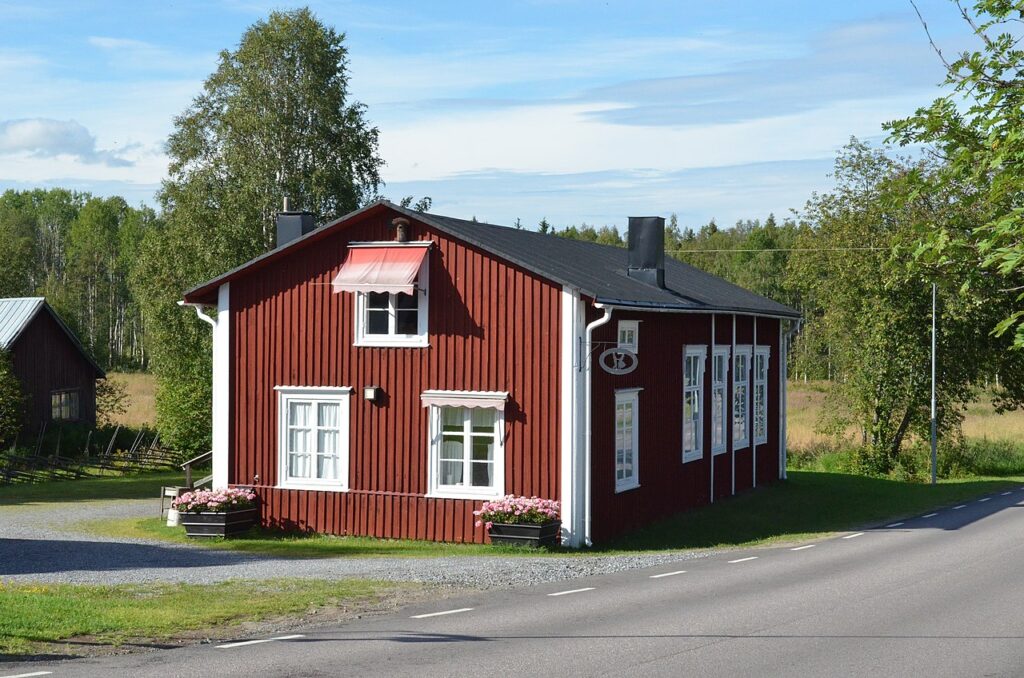
Gammelstad
One of Lapland’s top sights, Gammelstad, 11km northwest of Luleå, was added to the UNESCO World Heritage List in 1996. It is an outstanding example of what’s known in Swedish as a kyrkstad, a ‘church town’ consisting of over 400 timber cottages, which were used on Sundays and during religious festivals by people attending services in the spectacular late medieval stone church, Nederluleå kyrka, around which they are grouped. The cottages provided overnight accommodation for parishioners who lived too far away to make the journey to the church and back in one day.
Of Sweden’s 71 church towns, only 16 remain today, the largest and best preserved of which is Gammelstad, which consists of 408 gnarled wooden cottages. The combination of a strongly felt duty to attend church and the long distances involved in getting here, led to the construction of the church town in the mid 1500s. The ad hoc placing of the cottages suggests that the church town grew successively over the years, with cottages being added as and when they were needed. Miraculously, the kyrkstad has never been subject to fire. Traditions live on in Gammelstad and the cottages are used by parishioners three to four times every year when special ‘church weekends’ are held, or when confirmations take place shortly before midsummer.
What to see and do
Hägnan Open-Air Museum
Just down the hill from the cottages, Friluftsmuséet Hägnan is a rustic collection of old farmstead buildings spanning three centuries. They come from farms across Lapland and have been rebuilt in their original form to accurately portray country life from the 1700s onwards. Rural skills such as sheep shearing and flatbread making are also occasionally displayed.
Bus #9 runs roughly once an hour (timetable available at LLT) to Gammelstad from Smedjegatan in the centre of Luleå and takes about 35 minutes; alight at the stop called Kyrktorget.
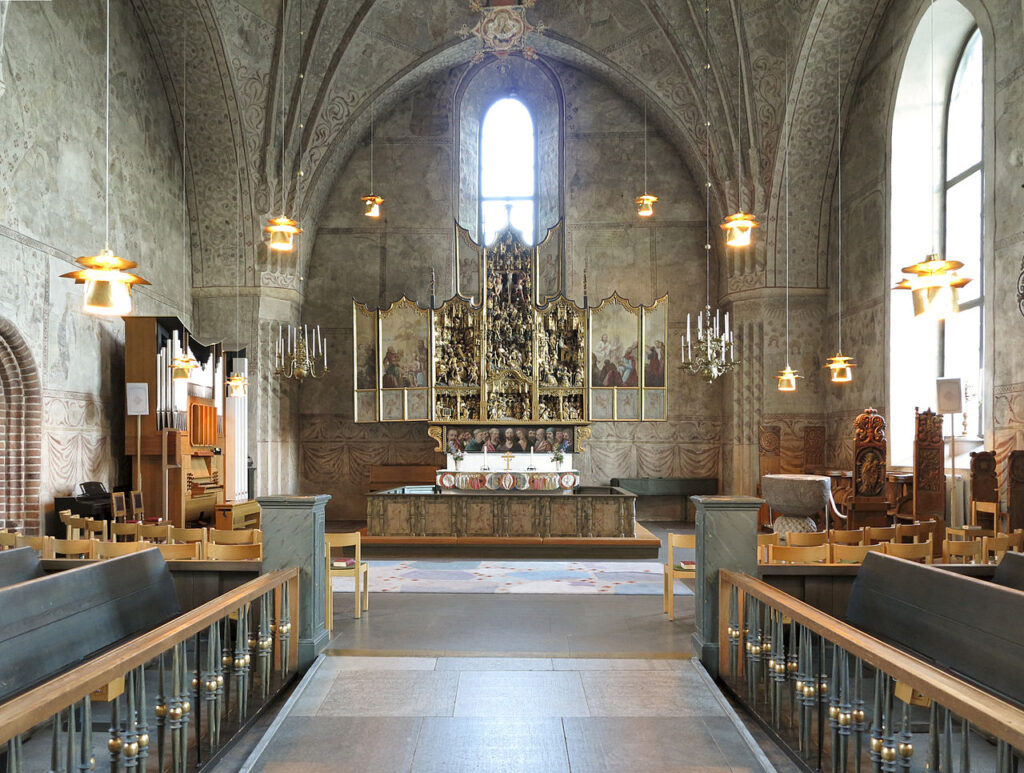
Nederluleå Church
The city of Luleå originally grew up around Nederluleå kyrka, which was built during the 15th century and inaugurated in 1492. The opulence of the building is a clear sign of the economic prosperity of the town at the time, which was based on fur trading in the Lapland interior and salmon fishing on the coast. Originally intended as a cathedral, this is the largest church in Sweden north of Uppsala. Indeed, the lookout slit in the eastern gable suggests it was a useful fortification during periods of unrest, allowing boiling oil to be poured over unexpected visitors.
The interior is ornate in the extreme. The altar screen with its finely carved wooden figures was made in Antwerp around 1520 at great cost to the local farmers who were presented with the bill. The ornate pulpit, replete with dashes of gilt, dates from 1712 and is the work of local carpenter, Nils Jacobsson Fluur.
Tourist information
The tourist office in Gammelstad is located in the heart of things at Kyrktorget 1 (visitgammelstad.se). In addition to a wealth of information about the church town, it also runs guided tours in English during the summer months (book online; 80SEK).
Harriniva Holiday Centre
The biggest and best husky centre (with around 400 dogs) in Lapland, the Harriniva Holiday Centre, 3km south of Muonio along Route 21 towards Tornio, is the place to get your doggie fix. Established in 1973 by husband-and-wife team, Köpi and Maria Pietikäinen, Harriniva has developed a reputation over the years for well-organised, good-value husky safaris that are hard to beat. During the winter season, 95% of guests here are foreign, predominantly from Britain, France, Germany and Holland, which gives the entire place an enjoyable, cosmopolitan air.
All accommodationat Harriniva is clean, comfortable and warm. Prices vary according to time of year; high season is early December to early January and February to early April. Rates quoted here are all high-season prices. Accommodation in winter tends to be block-booked months in advance and it is unlikely you will find availability without booking an inclusive package. In summer, however, things are different and there is plenty of availability.
Winter tours
There are various lengths of husky safaris available at Harriniva. At the top end of the scale, for example, a week-long tourwith your own dog-sled team, overnighting in log cabins with all food provided costs from €1,835. The cabins have wood-burning saunas but no running water or electricity. Although the pleasure of riding across frozen lakes and weaving your way deep through Lapland’s snow-covered forests doesn’t come cheap, it is not one you are likely to forget in a hurry.
Alternatively, Harriniva also operates snowmobiletours: a three-day safari covering up to 100km per day overnighting in log cabins, for example, costs €1,680 per person.
Summer tours
Between June and September, Harriniva specialises in trips on the Muonio River. There are white-water raft tourslasting 1 ½ hours for €45; or more sedate canoeing tours(min 4 people) of 2 to 3 hours at €50 per person. The Muonio River is considered one of the best salmon rivers in Finland and from the end of June to mid-August, salmon fishingis in season (€190 for a boat with an outboard motor and fishing equipment). Rowing boats are also available for rental at €35 per day. Since not all tours operate daily, it is best to check with Harriniva to find out exactly what will be available while you are there.
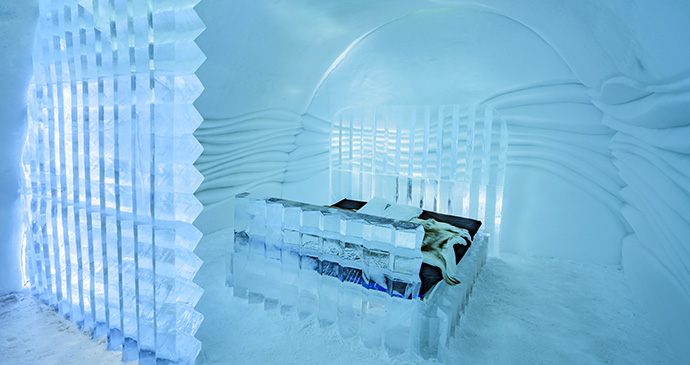
ICEHOTEL
If there’s one thing that’s put Lapland well and truly on the winter tourist trail, it is Icehotel. From Japan to Britain, the US to Italy, mention the name to any savvy traveller and everyone’s heard about it, and, more often than not, wants to come here. Proof, if ever it was needed, that the man behind the project, Yngve Bergqvist, a southern Swede who moved to Swedish Lapland over 30 years ago, struck gold.
Back in 1989, he hit on the idea of building a simple igloo here in the village of Jukkasjärvi(Sámi for ‘meeting place by the lake’), 20km east of Kiruna, as a showcase for local Sámi handicrafts and art. Some of those first visitors wanted to sleep in the igloo – something that wasn’t commerically possible in any part of Lapland at the time. A veritable niche in the market, the concept was developed by Yngve and Icehotel was born, gradually transforming sleepy Jukkasjärvi, a remote Lapland backwater, into a tourist blockbuster that now pulls in 40,000 visitors every year.
In late October each year, work begins in earnest on the (re)construction of Icehotel. Using blocks of ice hewn from the Torne River, which flows through Jukkasjärvi, artists and sculptors from across the world slowly give shape to thenew structure, which will consume around 1,000 tonnes of ice and 30,000 tonnes of ‘snice’, as Icehotel calls it, a combination of snow and ice which helps strengthen the structure.
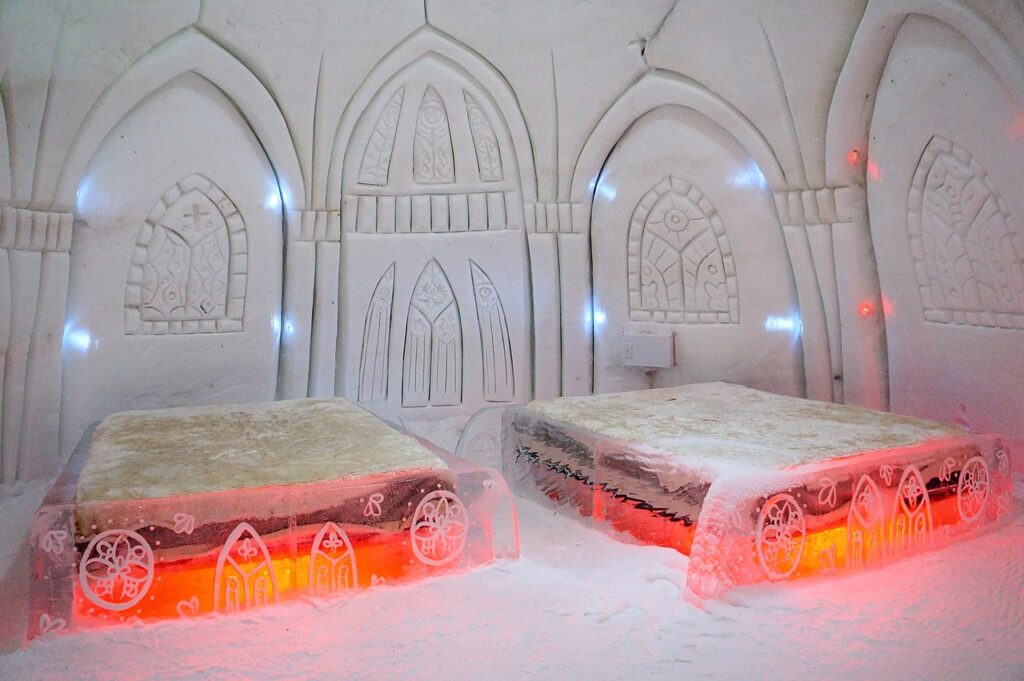
Whether you stay here or not, if you are in Lapland during the winter season, you should make every effort to get here because Icehotel really is an amazing sight. Although the actual details of the design and interior decoration vary from year to year, the overall shape of the hotel remains the same: one long arched corridor, naturally lit at either end by giant ice windows, forms the main walkway, from which other corridors then branch off to the left and right leading to the bedrooms and suites. Intricately carved ice sculptures adorn the interior seemingly at every turn and only add to the overall sense of amazement most visitors feel. Beside the main entrance, there’s the Ice chapel, a smaller arched igloo, replete with ice pews and cross, which has become an inordinately popular place to tie the knot.
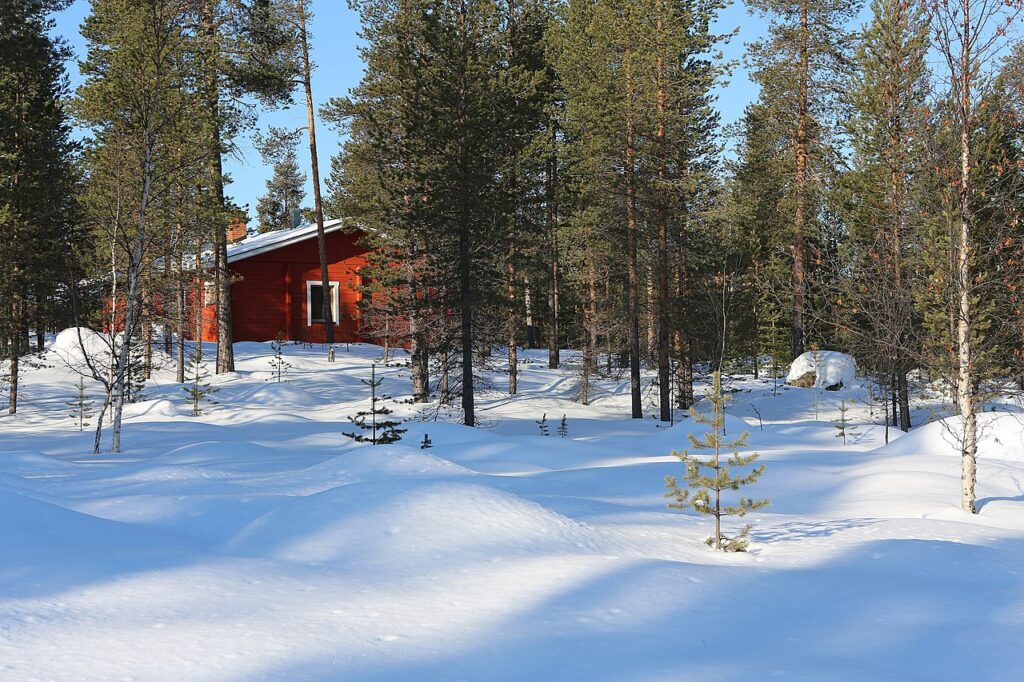
Inari
A short drive of 39km northwest from Ivalo, Inari is to Finland what Karasjok is to Norway. Home to Sámediggi, the Finnish Sámi parliament, Inari (Anár in Sámi) is the centre of Sámi culture in Finnish Lapland. Although other Sámi groups and Finns have moved into the region for various reasons (people were resettled in Inari, for instance, when Finland lost the Petsamo region to the Soviet Union in 1944), the Sámi have historically always lived in the same place, around the rocky shores of Inarijärvi lake (Anárjávri in Sámi), and today constitute a distinct ethnic group within the Sámi community as a whole, with their own traditional costume and language. However, Inari Sámi is threatened with extinction since its speakers total barely 300, many of whom are elderly or middle aged, and few schoolchildren are learning the language.
Although Inari is a pretty enough place to wander around for an hour or so, there are several reasons that make it an ideal stop on the long haul between Rovaniemi and the North Cape: the best Sámi museum in the whole of Lapland is here; an enjoyable hiking route out to a wilderness church starts from here; and boat trips on the steely waters of the lake are available during the summer months.
What to see and do
Inari is not the sort of place where you hurtle from one sight to another, ticking them off as you go; there aren’t any. Instead, prepare to learn more about the Sámi lands you are travelling through and the intimate relationship between indigenous man and nature at the Siida Museum beside the main road and on the banks of Inarijärvi Lake, one of the best museums in Finland and Inari’s main attraction.
Although the Sámi community in Finland is considerably smaller than that in Norway, the professional, contemporary approach to the museum’s contents and layout is sure to impress and there are clear lessons to learn for other museums elsewhere in the region. Other than the museum, a boat trip on Inarijärvi lake or a hike out to the Pielpajärvi wilderness church are the main reasons to linger.
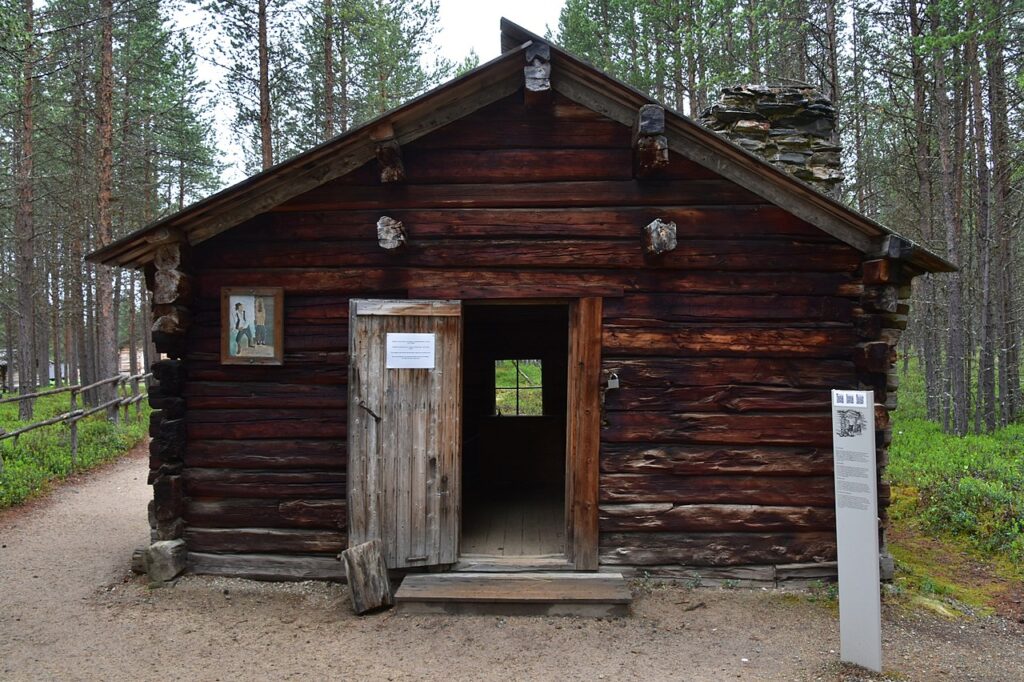
Siida Museum
From the entrance hall, a sloping walkway leads visitors to the main exhibition area on the first floor. Here, in a modest-sized room, an easy-to-understand timeline runs the circumference of the room recounting Sámi history from prehistoric times to the present day, placing events in Lapland alongside their chronological counterparts elsewhere in the world: for instance, while Che Guevara and Ayatollah Khomeini were at large, the Sámi were rejoicing at the completion of their new road to Sevettijärvi.
The key theme of the museum, though, is nature and as you step into the main exhibition space it is as if you are suddenly immersed in the wilds of Lapland’s fells. A series of floor-to-ceiling photographs measuring a whopping 10m wide by 5m high span the room, conjuring up resonant images of Lapland’s landscapes and seasons. The sound of birdsong, the howl of the wind and the gentle trickle of mountain streams, played from surround speakers in the ceiling, add to the sensation of being out in nature and at the mercy of the elements. From displays on the variegated flowers that carpet the Lapland fells in spring to the fascinating life cycle of the brown bear, the exhibition is a real treat for the senses.
Sajos
Diagonally opposite Siida on the southern bank of the Juutuanjoki River, Sajos is Inari’s pride and joy: the Sámi cultural centre here houses the Finnish Sámi parliament, a library of Sámi-language books, auditorium and a small café. Inspiration for the star-shaped building comes from Sámi handicrafts and the floorplan is said to resemble a reindeer skin or a Sámi man’s headdress, depending on your point of view.
The external walls are constructed from fire-resistant pine while inside spruce and birch are used extensively. Though as a visitor to Inari you’re unlikely to have much call for the Sámi administrative services available, the inspirational building, funded by the European Union’s regional development fund, is definitely worth a browse. Inside, you’ll also find Sámi Duodji, which has a wide range of tasteful souvenirs.
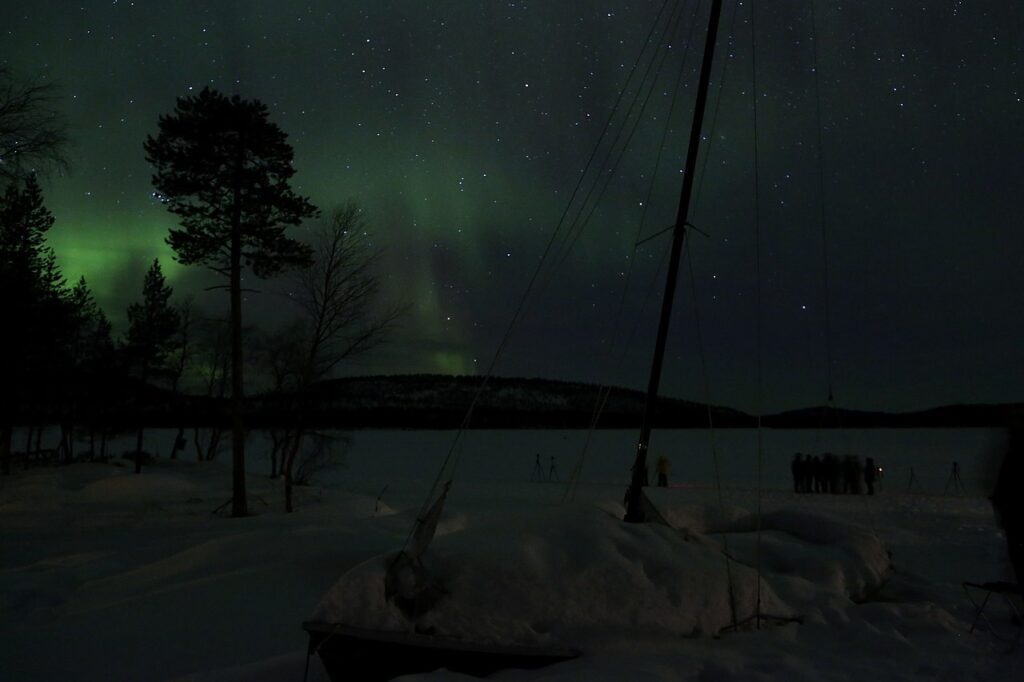
Inarijärvi Lake
Covering an area of over 1,000km² and containing more than 3,000 islands, Inarijärvi is Finland’s third-largest lake. To get an impression of the sheer scale of the lake, it is twice the size of Switzerland’s Lake Geneva or Lake Constance on the borders of Germany, Austria and Switzerland and is consequently known locally as ‘the Sámi sea’. For some truly spectacular views, head 7km south of Inari along Route 4/E75 back towards Ivalo and take the right turn signed ‘Digita Oy Inarin radio-ja tv-asema’, which will lead you up a steep hill to the site of Inari’s radio and television mast.
From the car park at the foot of the mast, there are sweeping vistas out across the island-studded waters that reach all the way to the Norwegian and Russian borders. The lake empties northwards into the head of the Varangerfjord, part of the Barents Sea, via the Paatsjoki River. Of the 3,000 islands in the lake, the best known are Hautuumaasaari (graveyard island), which served as a cemetery for the Sámi people in ancient times, and Ukonkivi, a historical place of sacrifice.
Lofoten and Vesterålen islands
The scenic highlight of any trip to Norwegian Lapland, the Vesterålen (pronounced ‘vester-oh-len’) and Lofoten (‘loo-fut-en’) islands are a rugged triangular-shaped archipelago off Narvik. Though totally void of Sámi culture, these green, mountainous islands make a perfect antidote to the remote villages of the forested heart of Lapland, and are readily accessible from Narvik, itself linked to Swedish Lapland by train and road.
The Vesterålen Islands
The Vesterålen islands (‘western isles’), predominantly Hinnøya, Langøya and Andøya, are the less dramatic of the two groups. Naturally, this being Norway, there are mountains wherever you look, but they are set back from the islands’ towns and villages, often forming a backdrop to a view, rather than being the view themselves. From south to north the peaks become gradually less pronounced and craggy in nature – indeed, the north of Andøya is not mountainous at all but given over instead to enormous lowland peat bogs, cloudberry marshes and even coal deposits.
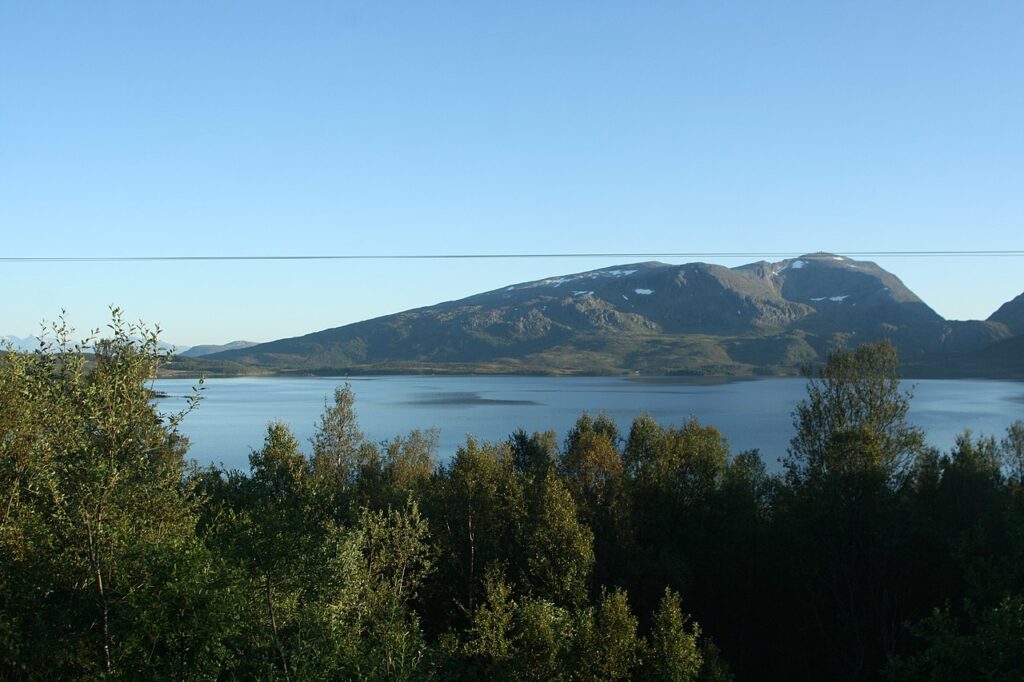
Harstad
The largest town in Vesterålen with a population of around 21,000, Harstad’s central position in the archipelago has always been its selling point. During the late 1800s, when plentiful catches of herring fuelled a boom in the local economy, the town became the perfect base for landing fish and transporting it to markets throughout the north, thanks to its good road connections. As herring stocks dwindled, Harstad turned to shipbuilding and maintenance; the production of shipping and fishing equipment; and even the import of coal from Svalbard, to make a living.
In more recent years, oil exploration has played a significant role in the local economy and today the northern headquarters of Statoil are here, plus Norway’s national producer of milk products, Tine, is also stationed here. If the number of heavy trucks that trundle in and out of town today is anything to go by, Harstad is still a key player in the distribution of goods throughout the north of the country.
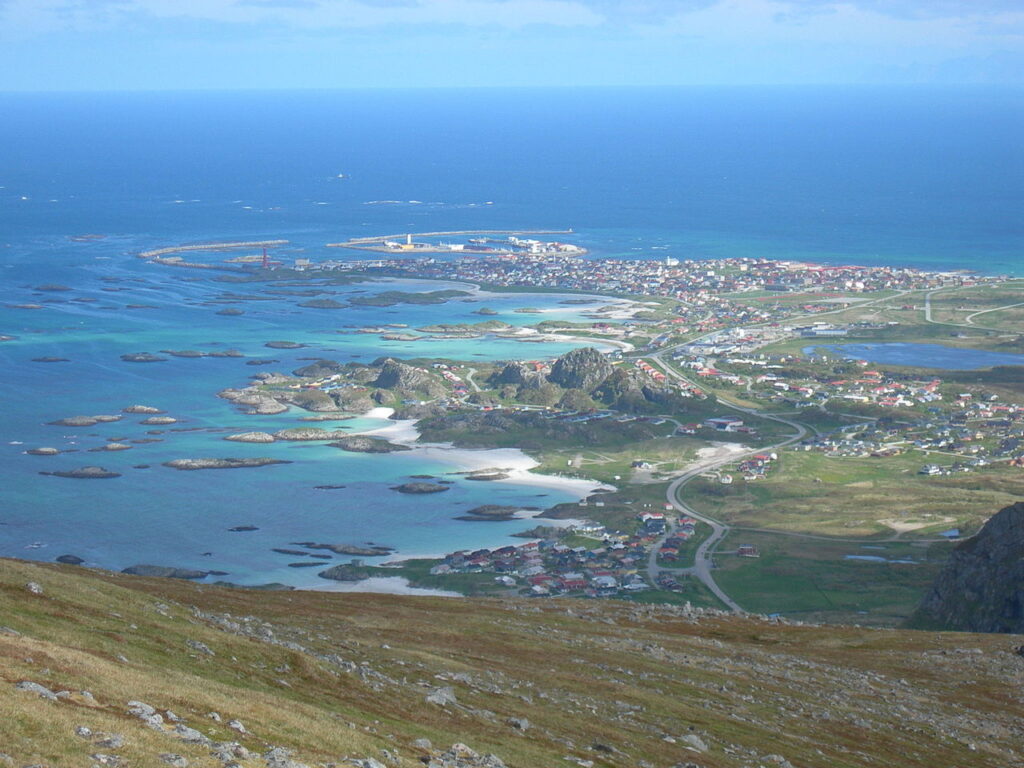
Andenes
It is the chance to go whale-watchingfrom Andenes, a small and rather attractive village, 100km north of Sortland, at the northernmost edge of Vesterålen, clinging to the very tip of Andøya Island, that brings most visitors to the islands.
There’s reputed to be a 95–99% chance of seeing whales on the safaris which leave daily from the harbour – sperm and minke whales are found in relatively large numbers in the waters off Vesterålen’s northern tip, but amazingly killer whalesare also present, which are the big attraction, and good enough reason to sign up for a whale safari here rather than elsewhere. Sperm whales are seen on most trips though it is hard to predict whether other species will put in an appearance. However, Andenes’s secret is its proximity to the continental shelf and the nutrient-rich feeding grounds in the vicinity, which draw whales to the area. Incidentally, Andenes is the location of a research centre for marine biologists who are studying cetaceans in the waters of this part of the Norwegian Sea.
Stokmarknes
Stokmarknes, famous in Norway at least as the birthplace of Hurtigruten, is the home of the specialists. As you cross the second of two bridges that lead into town you will catch sight of one of the line’s former vessels, Finnmarken, standing high and dry beside the quayside currently used for Hurtigruten departures. Linked to the adjacent building, Hurtigrutens Hus, by a walkway over the road, the ship forms part of the main attraction in Stokmarknes: the Hurtigruten Museum, an engaging collection of nautical paraphernalia that recounts the life and times of Norway’s most famous shipping line.
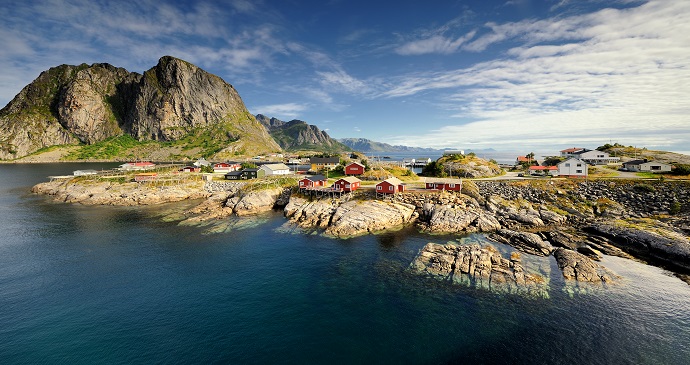
The Lofoten Islands
The Lofoten islands(named ‘lynx foot’ by the Vikings after their supposed resemblance) really are something special. Overwhelmed by the 100km-long Lofotveggen (Lofoten Wall), a spine of sheer, snow-clad granite peaks and ravines that runs the length of the archipelago and quite simply takes your breath away, the extreme forces of nature have left their unforgiving mark on the geography of these islands.
Smaller, narrower and infinitely more beautiful than their northern neighbours, their rearing mountains finally splinter into the Norwegian Sea beyond the beguiling village of Å in the south. Travel here is relaxed and enjoyable – the climate is generally mild and it is not uncommon for Lofoten to be bathed in warm sunshine while the mainland is depressed by heavy blankets of grey cloud. Spending the afternoon catching the rays on the rocks or the odd sandy beach or wandering through the winding backstreets of idyllic fishing villages is part of Lofoten’s charm and it is hard to find anyone who doesn’t succumb to this endearing side of island life.
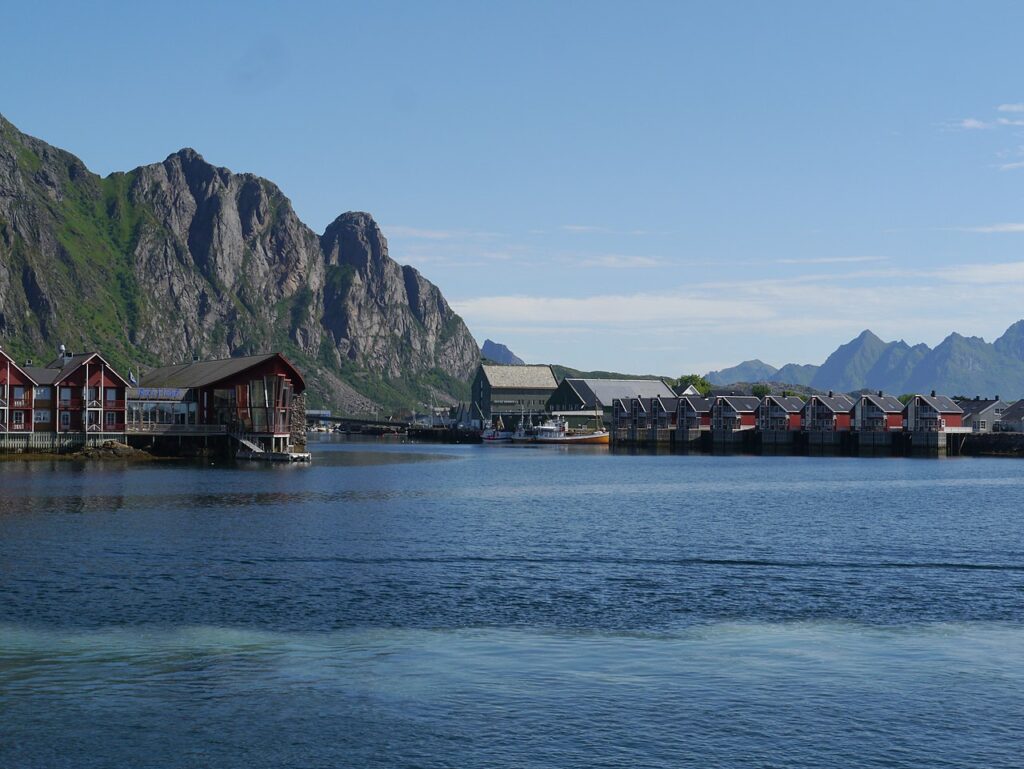
Svolvær
The charming, waterside town of Svolvær makes a great introduction to the Lofoten islands. True, it may not be as picture-postcard-perfect as the other small fishing villages to the south, but it is nonetheless an easy place to spend a couple of days simply chilling out in the harbour-front cafés and restaurants or heading out to the Trollfjord, if you missed it on your way here. In addition, Svolvær is one of the easiest places to reach in the entire island chain.
Not only is the town served by Hurtigruten, direct buses from Narvik and a handy car ferry across the waters of Vestfjorden from Skutvik (a straightforward and much shorter drive from Narvik than heading here along the E10) but there’s even an airport, 6km east of the town, with direct flights to the mainland.
Henningsvær
The drive out to tiny Henningsvær is simply gorgeous. The village is draped over the last island in a chain of skerries and islets that lie off the southwest corner of Austvågøy. Skipping from island to island, the minor road leading to the fishing village weaves its way around secluded sandy coves and rocky bluffs before it arches over a final narrow bridge and pulls into town. At the centre of the village is the harbour, a tight U-shaped inlet lined with handsome, brightly painted houses and boatsheds and backed by jagged peaks rising precipitously from the sea. It is a scene from a postcard and really is as beautiful as you might imagine. However, in season, it attracts coachloads of camera-snapping visitors who swamp the little place and steal its charm. Try to time your visit to early morning or late afternoon and you should have the maze of narrow lanes and passageways pretty much to yourself.
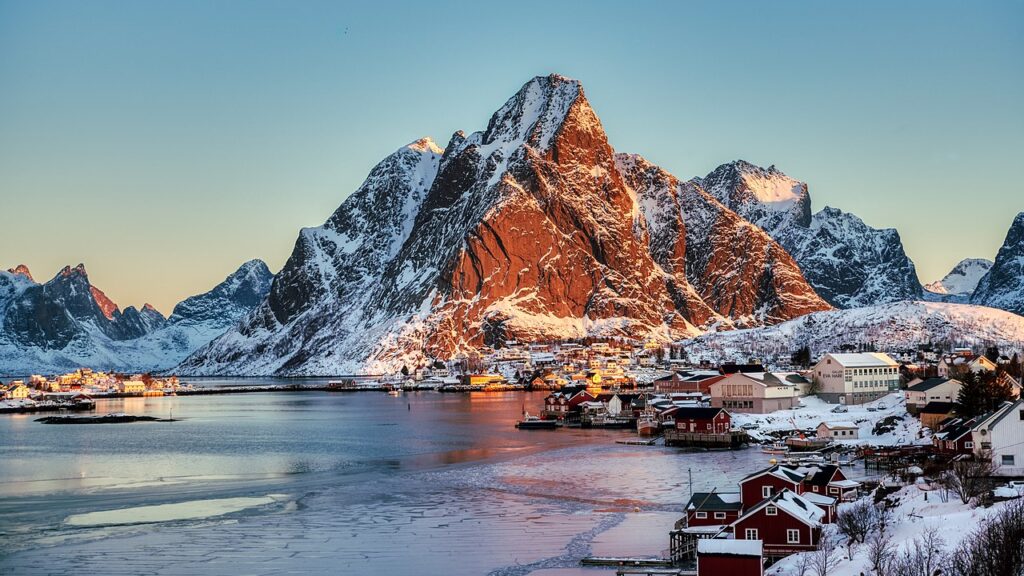
Reine
Reine is a ravishing beauty of a village, 41km to the southwest of Nusfjord. Reine perches atop a narrow promontory, linked to the mainland by a narrow causeway, just off the E10. From the viewpoint just off the main road, at a spot known as Reinehalsen, you will be treated to one of the most gorgeous views you can imagine: the timber houses of the village tumble across the small island, surrounded on all sides by bony islets, angular skerries and towering mountains.
What’s more, Reine is also the starting point for one of the best hikes in the whole of Lapland: from the top of Reinebringen (448m) you will be treated to panoramas of quite breathtaking beauty.
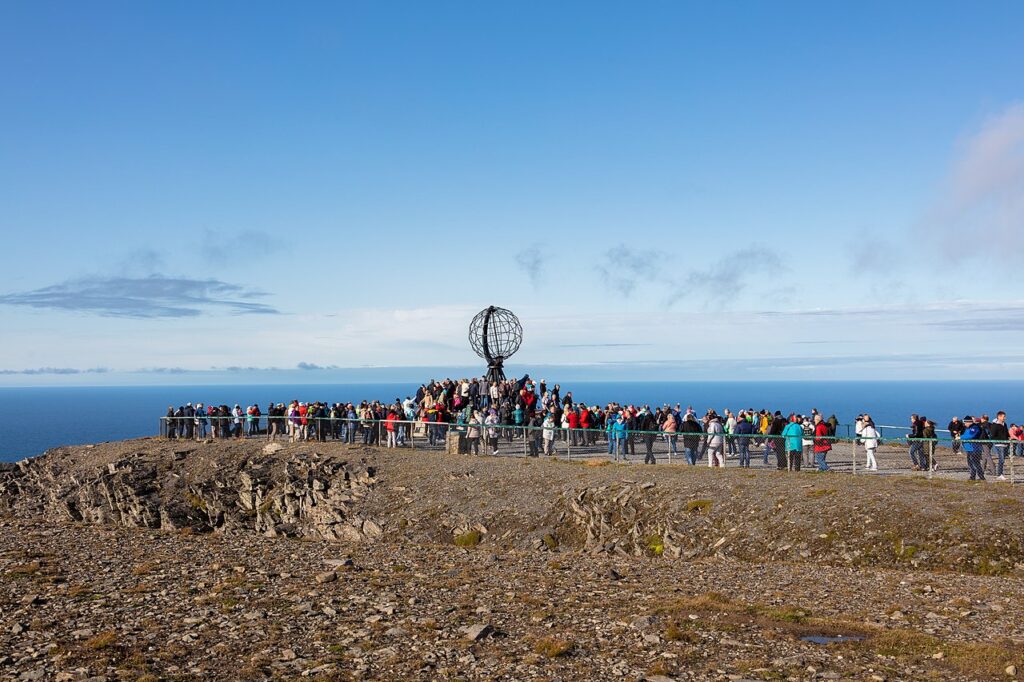
North Cape
The Sámi call Norway’s northernmost island Máhkarávju or ‘steep, barren coast’, which has been Norwegianised into today’s Magerøyaand is home to around 3,500 people, three-quarters of whom live in Honningsvåg. As the E69 threads its way north towards the cape (it only opened in 1956), the island certainly lives up to its name as vistas of bare, windswept rock and tundra unfold at every turn. This Arctic landscape is Norwegian Lapland at its most elemental: a high treeless plateau edged by distant frost-shattered peaks and a coast that has been gnawed into countless craggy inlets by the unforgiving might of the Arctic Ocean. Seeking shelter from the ferocious storms, which sweep in from the sea with merciless regularity, the island’s few settlements huddle at the head of fjords that slice deep into the heart of the land.
The belief that the North Cape is the furthest extremity of Europe is one of the greatest geographical gaffes of all time. The gently sloping promontory, Knivskjellodden, just to the west of the cape, is the true top of Europe since it stretches 1,500m further north than the cliff. Content not to let the truth get in the way of a good story, the Norwegian tourist authorities promote the North Cape (Nordkapp in Norwegian) as Europe’s most northerly point with all their might – and succeed: 200,000 people make the considerable journey to North Cape Hall every year and pay handsomely for the pleasure.
What to see and do
North Cape Hall
A commerical pleasure dome designed to relieve you of as many kroner as possible in a short space of time. The hall, cut into the rock of the cape, is not without its critics either, who claim it is grossly overpriced and has destroyed the natural environment. Be that as it may, it would be churlish not to go inside having made the journey here. The main building is divided into two sections, which are linked by an underground tunnel. As you enter from the car park, you will find a souvenir shop selling seemingly everything your heart could ever desire, emblazoned with the Nordkapp logo; a café serving coffee and cakes; the Kompasset café and restaurant, offering superb views of the Arctic Ocean through its floor-to-ceiling windows and some of the most expensive à la carte dishes anywhere in Norway; and a red postbox for that all-important ‘9764 Nordkapp’ postmark.
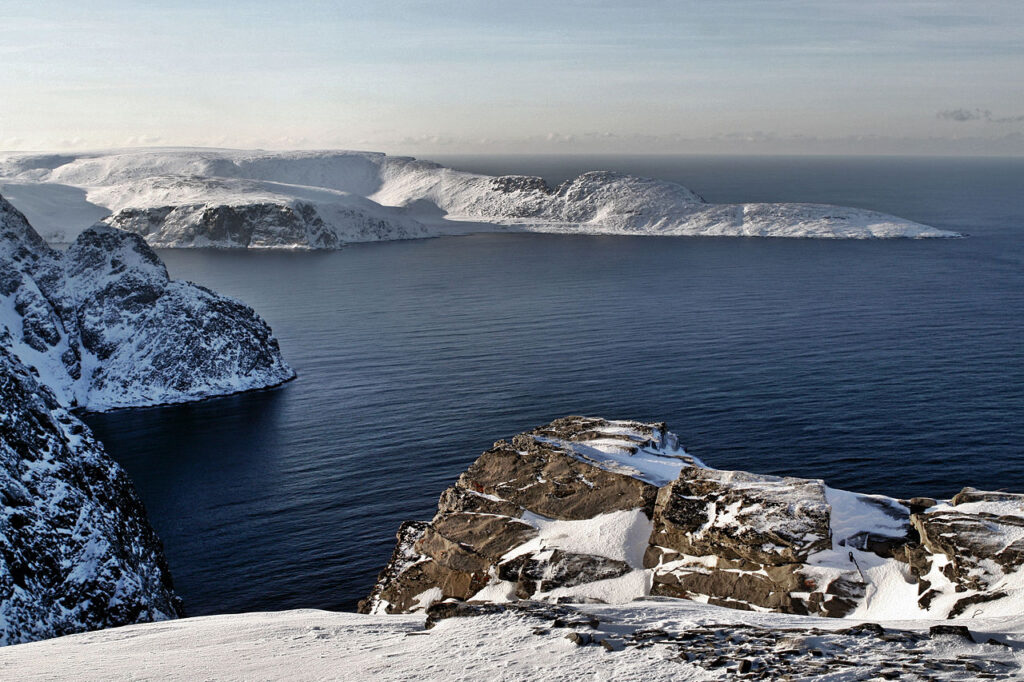
Hiking to Knivskjellodden
Should your thirst for last places not have been quenched by Nordkapphallen and its tourist paraphernalia, you might want to escape the crowds and hiketo the real northernmost point of Europe, Knivskjellodden. The start of the 16km (return; moderate) trail is signed from the E69 about 6km before the North Cape Hall and heads off towards the northwest; there’s a car park here at the beginning of the trail.
Don’t underestimate how fast the weather can change out here on the plateau and before embarking on the hike you should make sure you are properly equipped; allow about 6 hours to make the return hike from the road. Perhaps in response to their critics, the North Cape Hall’s operators, the Scandic hotel chain, urge visitors not to build cairns since they damage the soil and vegetation, and not to drive their vehicles off the roads provided.
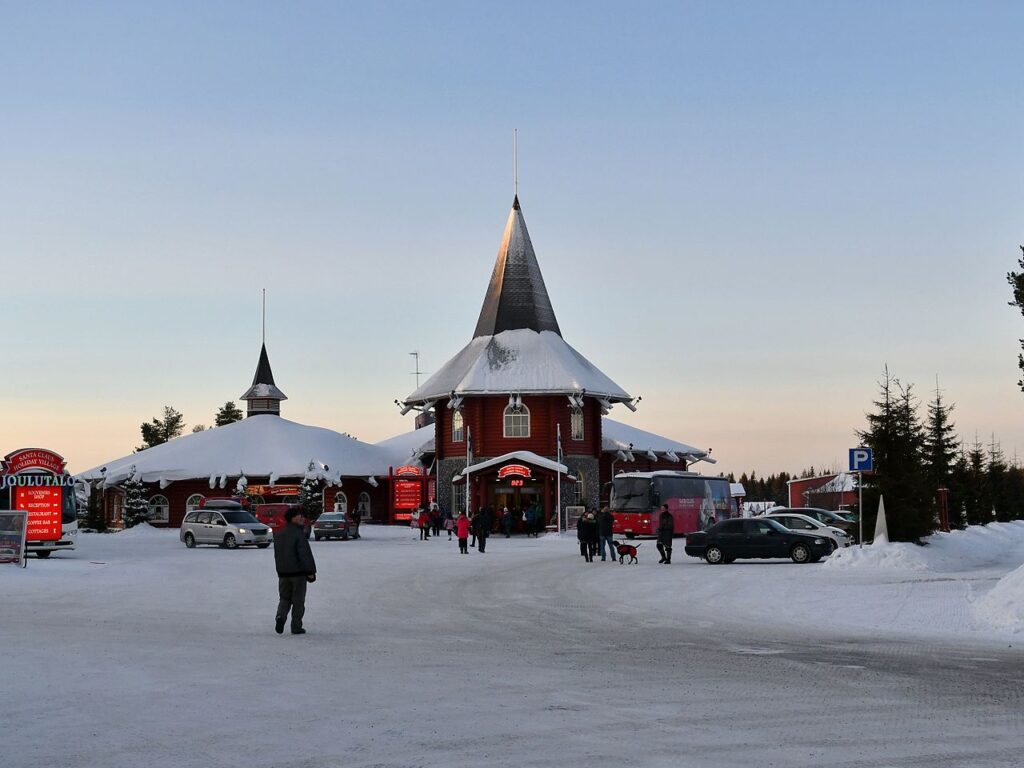
Santa Claus Village
Think what you might about a tourist attraction based around the delights of meeting a child-loving old man with a long white beard dressed in a red suit, the Santa Claus Villageis one of Finnish Lapland’s most visited sites.
Located smack bang on the Arctic Circle, an imaginary line drawn around the globe at latitude 66° 32’ 35”N, it is easily accessible from Rovaniemi along Route 4 or by daily bus8 (€3.50 one-way; 30mins; every 45mins), which leaves from the railway station and then calls at several stops in town, each emblazoned with an Arctic Circle/Santa Claus logo.
The first thing most people want to do when they arrive here is pose beside the Arctic Circle sign, which is located between the car park and the main entrance, and take lots of photographs. Give yourself over to this indulgence and snap away – it is one of the few signs marking The Circle, which is labelled in six different languages, though tellingly, not one of them is Sámi.
From here it is a short walk to the main building, Lahjatalo, which also goes by the name of the Santa Claus Gift House. Inside, on two floors, you will find a number of souvenir shops selling everything from T-shirts to reindeer skins in addition to a couple of cafés serving coffee, cakes and light snacks. It’s also here that you will find an information desk with helpful staff who can help you out with any queries you might have.
The low building with a central tower immediately behind the gift house is where Father Christmas himself hangs out inside the Santa Claus Office. Here, if you form an orderly queue, you can enter Santa’s grotto and come face to face with the big guy with the beard. Whether you have children in tow or not, it is actually quite a fun thing to do – even if it is only to marvel at how the Finns have pulled off this masterpiece of self-promotion. Hidden among the trees behind the Santa Claus Office, you will find a reindeer enclosure where, if you’ve just jetted in, you are likely to get your first sighting of Lapland’s best-known animal – though only between early December and early January.
Having placed your order for a new Ferrari next Christmas, head out the door of the Santa Claus Office to your left and cross the courtyard to the other building with a tower, the Santa Claus Post Office, where you can leave your name and address for the dubious pleasure of receiving a Christmas letter from Santa. If you still haven’t had your fill of Santa, you can head off to the Christmas Exhibition in the building immediately behind the post office, where there’s more information than you could ever hope to digest about Christmas traditions as well as centuries-old Christmas customs in Finland and elsewhere in the world – though, to be honest, you’ll probably be suffering from Santa-fatigue by this stage.
Suvanto
Due east of Luosto and reached via Pyhä on Routes 962 and 9621 (a total distance of 44km), the ravishing village of Suvanto is immediately different. It is the only settlement in the whole of Finnish Lapland where all the buildings survived the destruction of the Germans as they retreated. It’s not known why the Germans soldiers never reached Suvanto to set fire to the village as they did elsewhere in the province – but the result is breathtaking: houses, barns and storerooms of gnarled timber titillate the senses at every turn. In short, you should make every effort to get here to fully appreciate what Finnish Lapland used to look like and to comprehend the full horror that unfolded as entire villages and towns were systematically torched in the closing stages of World War II.
Before you cross the bridge into the village itself, pause and turn left into the visitor car park and you’ll see the old cable-guided ferrywhich once shuttled back and forth across the Kitinen River and provided the only access to the village – Suvanto’s relative isolation is one theory, at least, as to why the Germans never got here. Today, all the buildings in Suvanto are protected by Finland’s Board of Antiquities and Historical Monuments.
From June to mid-August a modest museum(free) is open in the village school which you’ll see signposted ‘Museokoulu’ off to the right as you enter the village. Look out, too, for the small gallery and café, Säpikäs, housed in a renovated barn where work by some of the artists, who come here to paint the old buildings, is on display.
The Village Houses
Although Suvanto was first settled in the late 1700s, the current wooden buildings date, in general, from around a century later. Located on the northern shore of the river (and, hence, south-facing) in large open flower meadows, the buildings are designed according to the building techniques of the day – namely grouped around an open courtyard. Typically, the main dwelling house faces the cowshed across the courtyard, while on the third side a warehouse is usually found. Granaries, drying houses, smoke saunas and barns are then located outside the central courtyard. The buildings, all hewn of impressively sized logs, are just one storey in height and are usually heated by a stone oven. The colourful verandas, which you’ll see adorning many of the dwelling houses, were added in the early 1900s, painted in lighter colours than the rich red ochre which decorates the outer walls of most of Suvanto’s buildings.
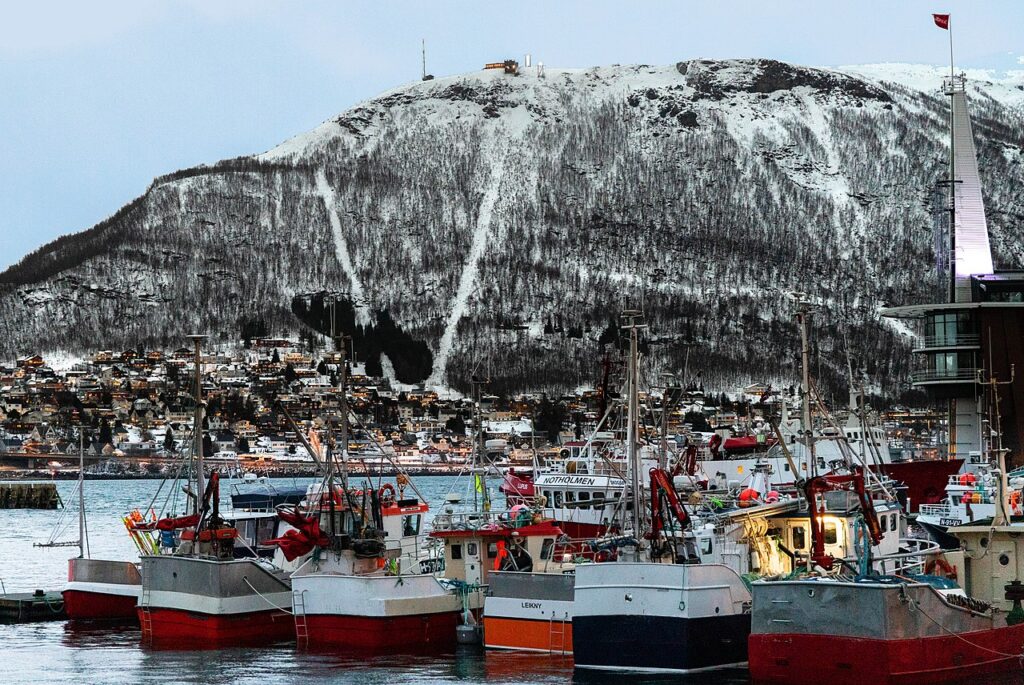
Tromsø
The ‘Gateway to the Arctic’, as the city thrills in billing itself, Tromsø (Romsa in Sámi) is one of the undisputed highlights of Norwegian Lapland. Although geographically well out on a limb, it is worth making a special effort to get there to enjoy some rare urban sophistication, the like of which you won’t find for miles around. Once known, quite ridiculously, as the Paris of the North, Tromsø can nevertheless boast a sophisticated café and restaurant culture, top hotels and several big-name stores; it has a couple of superb museums which will no doubt whet your appetite to learn more about the Arctic and maybe even to go there.
With a population of 73,000, Tromsø is the second-biggest town in Lapland, but if you talk to locals you will soon discover that they don’t consider themselves to live in Lapland (despite the confusing fact that the town uses a reindeer as its emblem). For the record, Tromsø is the capital of Troms, a Norwegian province that is further north than both Sweden’s Lappland and Finland’s Lappi, two administrative regions, which, for people who live there, most definitely are part of Lapland. For most Norwegians living here, Norwegian Lapland doesn’t begin until they cross the provincial border into Finnmark (the region which includes Alta, Karasjok, Kautokeino and all points east to Kirkenes). Most visitors seem happy to let the Norwegians argue among themselves, since as far as they are concerned everything above the Arctic Circle is Lapland – Swedish, Finnish or Norwegian.
What to see and do
Tromsø Cathedral
In the town centre, the main sight is the domkirke, built in 1861 in Gothic Revival style, which dominates the surrounding streets from its imposing position in Stortorget off Kirkegata; for what it’s worth, this is the northernmost Protestant cathedral in the world and the only one in Norway made of wood. The construction of the handsome timber building was part funded by the town’s merchants who had grown rich on the trapping trade in the Arctic. Sadly, due to a lack of volunteers, the cathedral is usually closed. However, you can see the interior every afternoon and evening when classical music concerts are held here during the summer months.
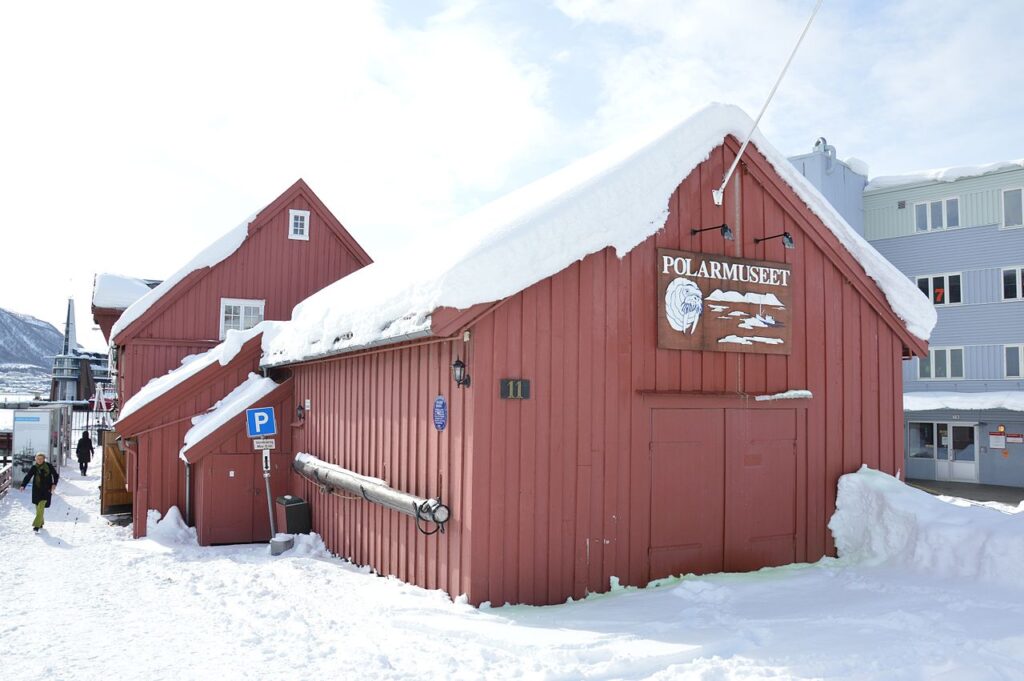
Polar Museum
Enjoying a prime location on the harbour front, Tromsø’s Polarmuseet is housed in a former customs warehouse dating from 1830 and contains some of the most fascinating exhibits you will find in Lapland.
It is fitting that Tromsø has an entire museum dedicated to its links with the Arctic, since the town owes much of its prosperity today to the hunters and trappers who based themselves here during the first half of the 19th century.
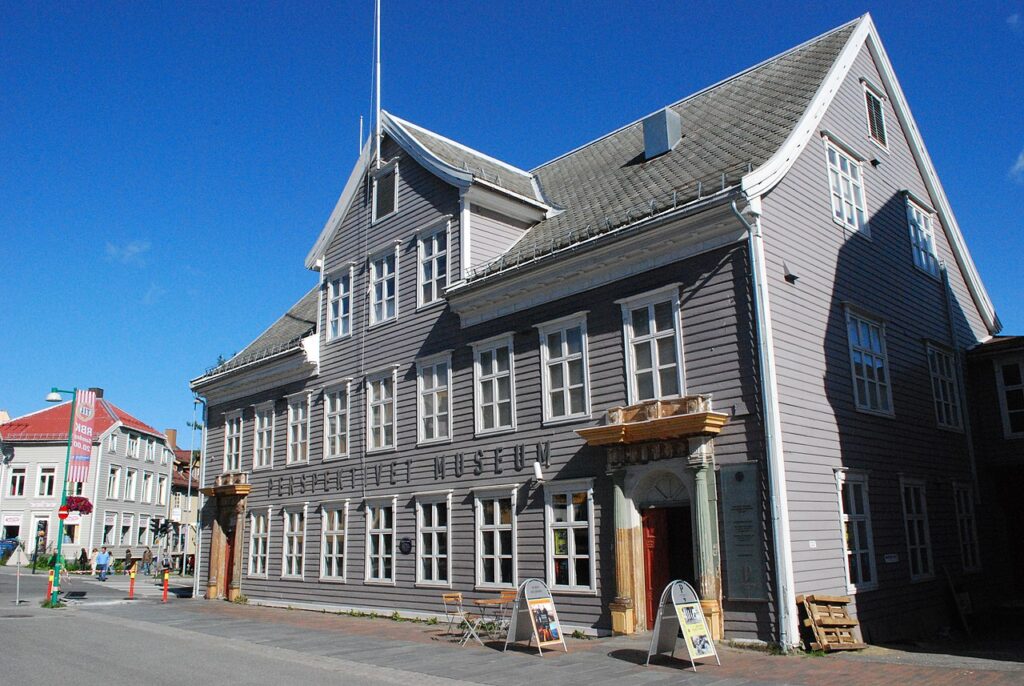
Perspektivet Museum
From the Polarmuseet it’s a short stroll west along Bispegata to reach one of Tromsø’s best, but often overlooked, museums: Perspektivet. Predominantly a photographic museum, Perspektivet aims to recount the contemporary history of Tromsø and has a collection of 400,000 images to draw on. Exhibitions change frequently, though there is usually a section devoted to what’s known as the ‘Pomor trade’ – commercial dealings between Russian fishermen and businessmen in the north of Norway which gave rise to a pidgin language ‘russenorsk’.
The building the museum occupies is also of interest as it was the teenage home of local writer, Sara Fabricius (1880–1974). After moving here from Oslo at the age of 13, Sara lived in Tromsø for five years – a period which left clear marks on her literary work; her breakthrough came under the pseudonym of Cora Sandel with the publication of her debut novel, Alberte and Jacob, in 1926. A modest exhibition in the museum recounts key moments in Fabricius’s life – today she’s regarded as one of Norway’s most significant authors.
Related books
For more information, see our guide to Lapland:
Related articles
There’s not a hot cross bun in sight!
Our expert author’s guide to the best spots in the region for catching a glimpse of those iconic green hues.
There are many national parks in Europe that remain fairly unknown. Here you can discover 14 of the best. Why miss out on visiting somewhere spectacular?
